Version 25.3 for Sparkrock 365 2024 release wave 2 release notes Published April 2, 2025
These release notes include supplemental information about version 25.3 for Sparkrock 365 2024 release wave 2.
Video
The following video includes information about the new features and enhancements in version 25.3 for Sparkrock 365 2024 release wave 2.
Highlights
The following sections highlight the major accomplishments in this release.
Assign allowances on gradual return to work HR requests based on date
Dimension mapping for employer contribution and employer tax liabilities
Load substitute position assignment data into the employee experience worksheet
Support for identifying HR employee assignments without allocations
New benefit-related fields to improve payroll administration
New features and changes
Version 25.3 for Sparkrock 365 2024 release wave 2 introduces exciting new features and enhancements to existing functionality.
Microsoft Dynamics 365 Business Central 2024 Release Wave 2
The base Microsoft Dynamics 365 Business Central platform that powers Sparkrock 365, has been updated from 24.5 to 25.3.
For more information about Microsoft Dynamics 365 Business Central releases since 24.5, select the following links:
To view a detailed list of cumulative platform fixes that are available from Microsoft, see Update history for Microsoft Dynamics 365 Business Central.
Modern search
This release introduces a modern search option on list pages that focuses exclusively on columns that are enhanced with full-text search capability.

The modern search accelerates the search process and delivers more precise, relevant results, which increases user satisfaction and productivity.
If required, you can still perform a search with the older method. This older method is now referred to as a legacy search. The legacy search searches across all columns, while the modern search only searches in columns that have been optimized for full-text search matching.
The new full-text search is more flexible. For example, consider an item named LONDON Swivel Chair. If you perform a legacy search with the search criteria of London chair, the search results do not display any records because there’s no exact match. However, if you perform a modern search with the same search criteria, the search results display the item.
The modern search also allows users to enclose search terms in quotes to narrow the results, similar to popular search engines. For example, searching for blue chair, returns all items that include blue and chair in any order. Searching for "blue chair" only returns records where the exact phrase blue chair appears.
The modern search feature is currently available on the following Sparkrock 365 list pages:
- Customers
- Contacts
- Items
- Chart of Accounts
If a page isn’t optimized for the modern search, the Use modern search (faster) option does not appear in the search box.
In subsequent updates, you’ll start to notice this feature on more list pages, such as sales and purchase documents, Projects, G/L Entries, Customer Ledger Entries, Vendor Ledger Entries, and Job Ledger Entries.
If you would like to have the modern search experience added to a specific page, contact your Sparkrock 365 representative.
For now, an administrator can use the feature management functionality to control whether the modern search is enabled on list pages. In a future release, the modern search feature will become the default search method.
To learn more about searching in Sparkrock 365, go to Sort, search, and filter data in lists, reports, or XMLports.
New Documents FactBox for attachments
Before this release, to view the attached documents for a Sparkrock 365 record, you had to select the record, and then select the link that appeared in the Attachments FactBox to open the Attached Documents page.
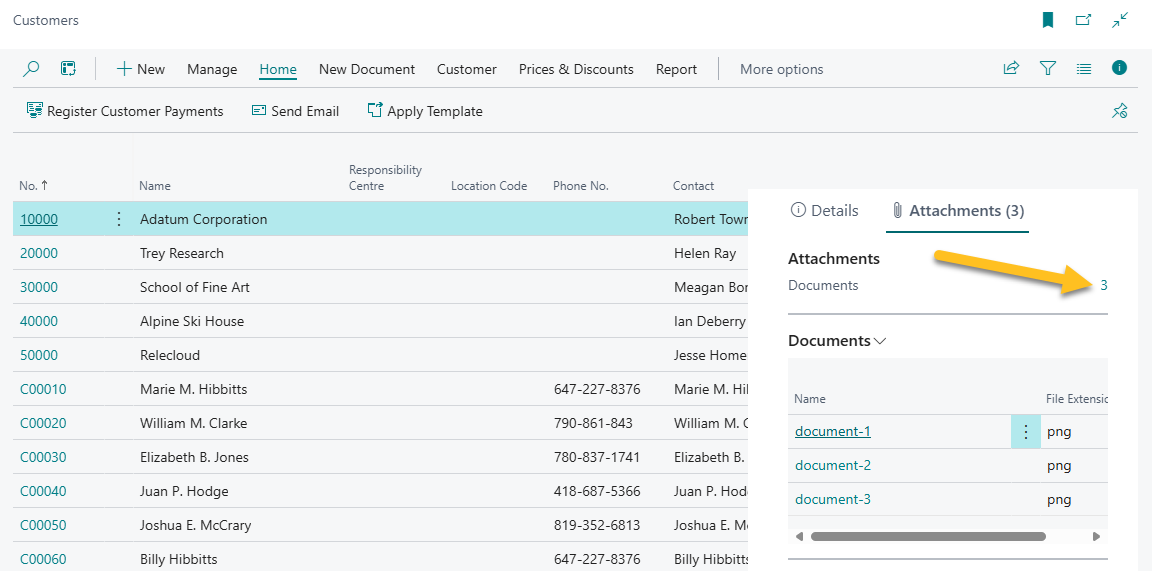
To provide an overview of uploaded files without having to open the Attached Documents page, this release introduces a Documents FactBox.
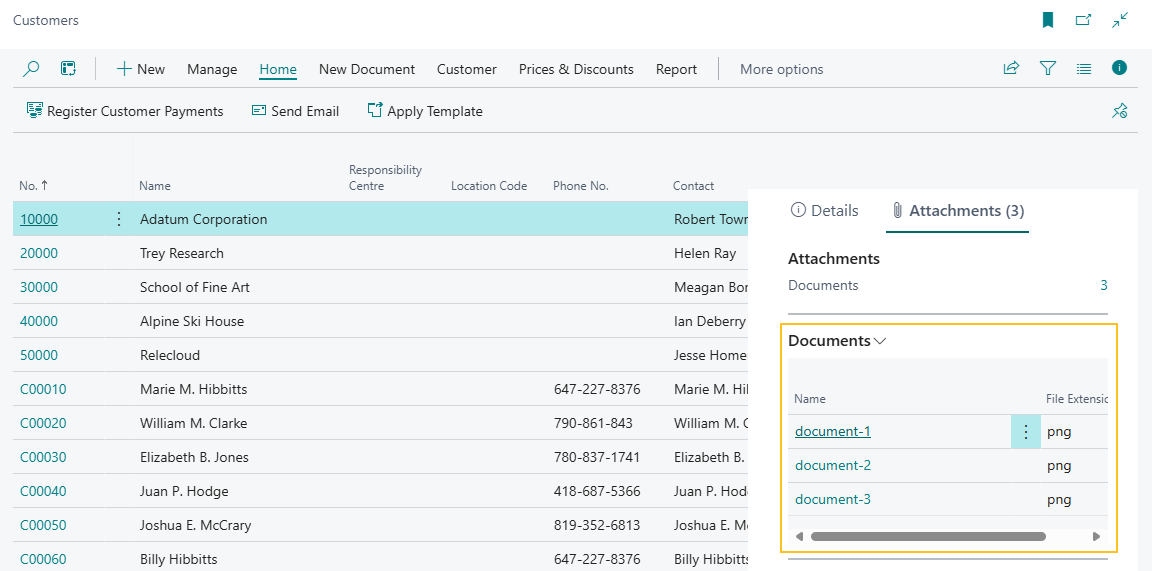
The Documents FactBox comes with the same set of actions that you can perform from the Attached Documents page.
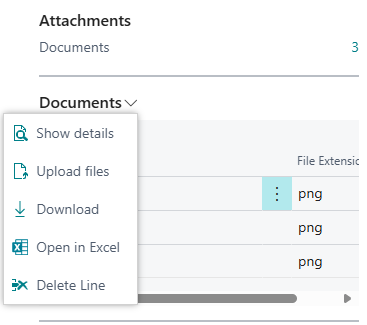
In addition to base Business Central pages, you can view the new Documents FactBox on the following Sparkrock-developed or extended pages:
- Absence Requests and Absence Request
- Applicants and Applicant
- Bank Deposit and Posted Bank Deposit
- Budget Journal
- Cash Receipt Journals
- Collective Agreements and Collective Agreement Card
- Commitment Entries
- Employees and Employee Card (User must have the Allow User to Access Compensation Data checkbox selected on the User Setup page)
- Employee Appraisals
- Employee Associations
- Employee HR Tasks
- Employee Qualifications
- Encumbrance Entries
- Expense Claim and Expense Claim Archive
- General Journal
- G/L Budget Plans, G/L Budget Sets, G/L Budget Set Card, and G/L Budget Entries
- General Ledger Entries
- Grievances and Grievance Card
- Harassment Complaints
- HR Positions and HR Position Card
- HR Requests and HR Request
- HR Task Types
- Items and Item Card (Except when the user has the Finance Department Manager or HR Department Manager roles)
- mySparkrock Change Entries and mySparkrock Change Card
- Payment Journals
- Payment Request and Payment Request Archive
- Posted Purchase Credit Memos and Posted Purchase Credit Memo
- Purchase Invoices, Posted Purchase Invoices, Posted Purchase Invoice
- Posted Purchase Receipt
- Purchase Lines
- Purchase Orders, Purchase Order, and Purchase Order Archive
- Purchase Receiving
- Purchase Requisition, Purchase Request Lines, and Purchase Requisition Archive
- Unassigned Expenses
- Vendors and Vendor Card (Except when the user has the Finance Department Manager or HR Department Manager roles)
- Vendor Certifications and Vendor Certification Card
For limited access users, the Documents FactBox includes a Documents field that displays the number of attachments that are associated with the selected document.

Users can select the document count link to open the Attached Documents page.
The Documents field appears on the following limited access pages:
- Expense Claim
- Payment Request
- Posted Purchase Credit Memos
- Posted Purchase Credit Memo
- Posted Purchase Invoices
- Posted Purchase Invoice
- Posted Purchase Receipt
- Purchase Orders
- Purchase Order
- Purchase Receiving
- Purchase Requisition
To learn more about attachments, go to Manage attachments, links, and notes on cards and documents.
Use drag and drop to attach multiple files at once
This release introduces drag-and-drop functionality, so you can attach multiple files to Sparkrock 365 records at once.
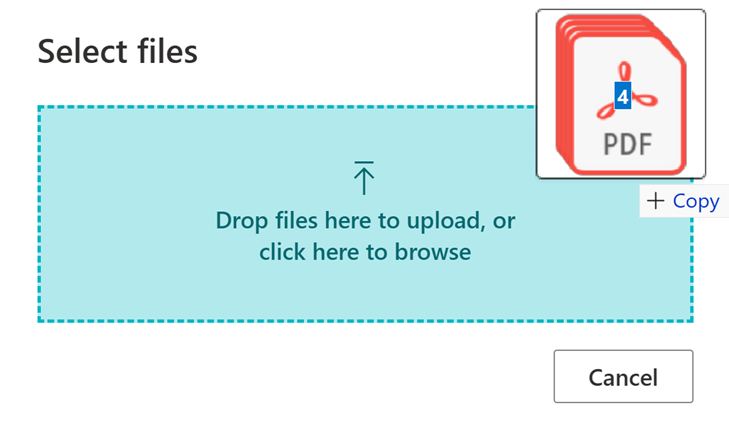
The Select files dialog box is available from the following pages and actions:
Attached Documents page > Attach files action

Documents FactBox > Upload files action

Incoming Documents page > Upload supporting attachments action

To attach multiple files to a Sparkrock 365 record at once, you can select the files, and then drag and drop the files into the Select files dialog. Additionally, you can drag and drop a folder into the Select files dialog to attach the contents to the Sparkrock 365 record.
To learn more about attachments, go to Manage attachments, links, and notes on cards and documents.
Default G/L Account Quantity
When working on document lines, some users prefer to enter a specific quantity, while others prefer a default value that can be overwritten if required.
To accommodate users who prefer a default value, Sparkrock 365 now provides the capability to have a default value of 1 specified on document lines that have a Type of G/L Account.

To enable this feature for sales and receivables documents, on the Sales & Receivables Setup page, turn on Default G/L Account Quantity.
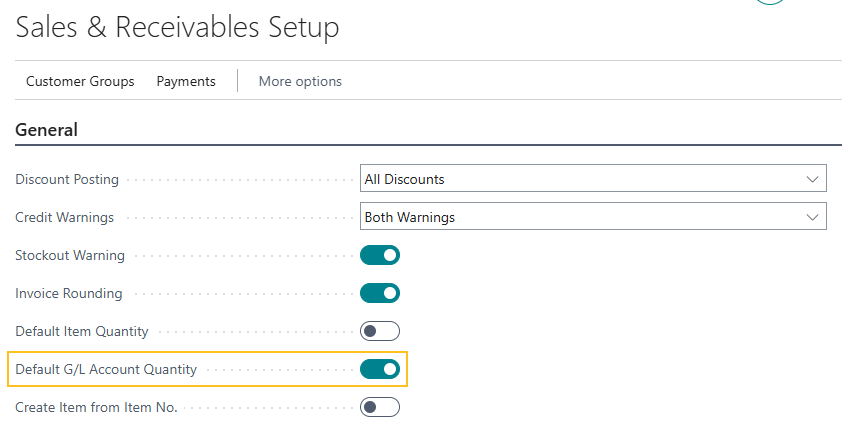
If you do not enable this feature, the Quantity field on sales and receivables documents behaves the same as previous releases.
To enable this feature for purchases and payables documents, on the Purchases & Payables Setup page, turn on Default G/L Account Quantity.
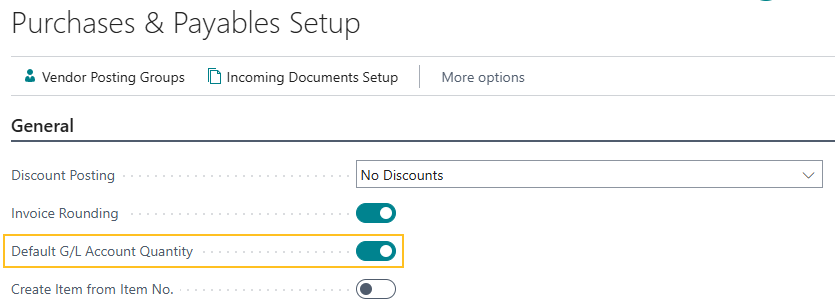
If you do not enable this feature, the Quantity field on purchases and payables documents behaves the same as previous releases.
Bank account reconciliation improvements
To help reduce manual effort during bank account reconciliation, this release introduces several productivity enhancements.
The following sections describe these enhancements in detail.
New Date Cleared on Check Ledger Entry field on the Bank Acc. Reconciliation page
On the Bank Acc. Reconciliation page, this release introduces a Date Cleared on Check Ledger Entry field.
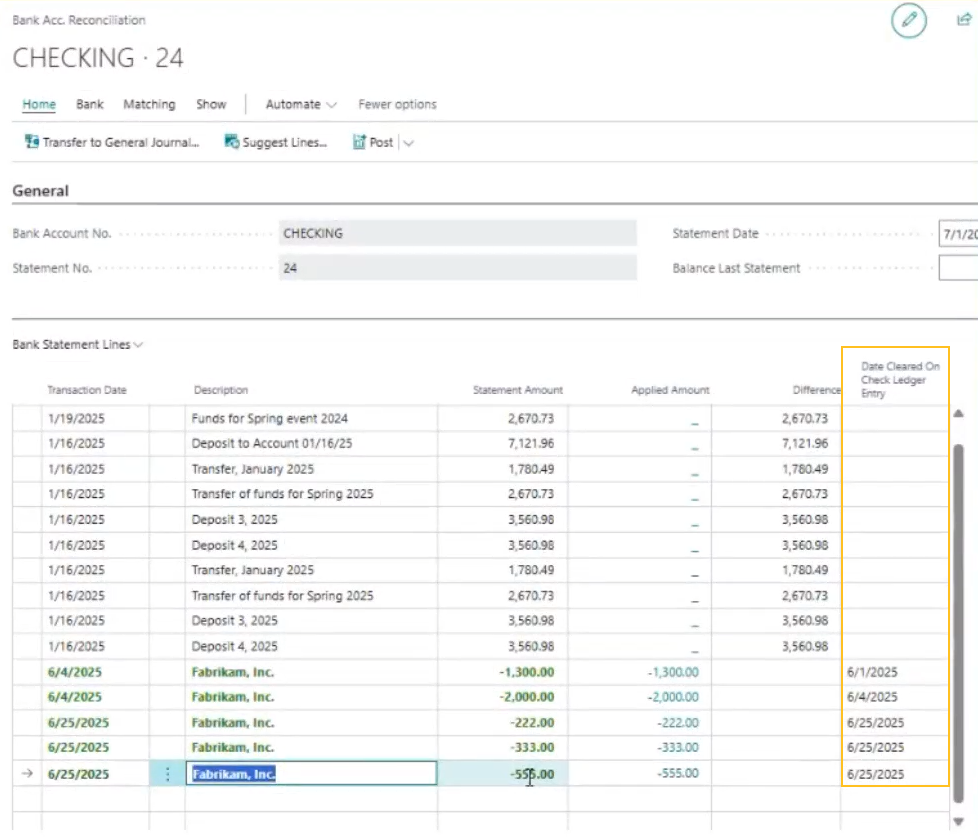
The Date Cleared on Check Ledger Entry field specifies the date on which a check was cleared in the check ledger. Sparkrock 365 automatically populates this field when you perform a Suggest Lines action, using the Date Cleared value for the related Document No. on the Check Ledger Entries page.
You can use the Date Cleared on Check Ledger Entry field to filter bank account reconciliation records by date or to identify records that have not yet cleared.
Date Cleared field and Entry Cleared checkbox on check ledger entries are automatically updated when payment journal lines are posted or a check is voided
Starting with this release, when a payment journal line is posted for a document that has Bank Payment Type set to Electronic Payment, Sparkrock 365 performs the following actions:
Populates the Date Cleared field on the Check Ledger Entries page that is associated with the document, with the Posting Date from the payment journal.
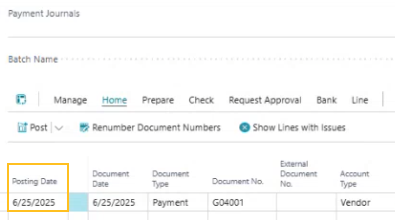

Selects the Entry Cleared checkbox on the same check ledger entry.
PD-5301 
If a check is voided on the Check Ledger Entries page, Sparkrock 365 performs the following actions that relate to the Date Cleared field and the Entry Cleared checkbox:
Updates the Date Cleared field with the Void Date from the Do you want to void this check? page.
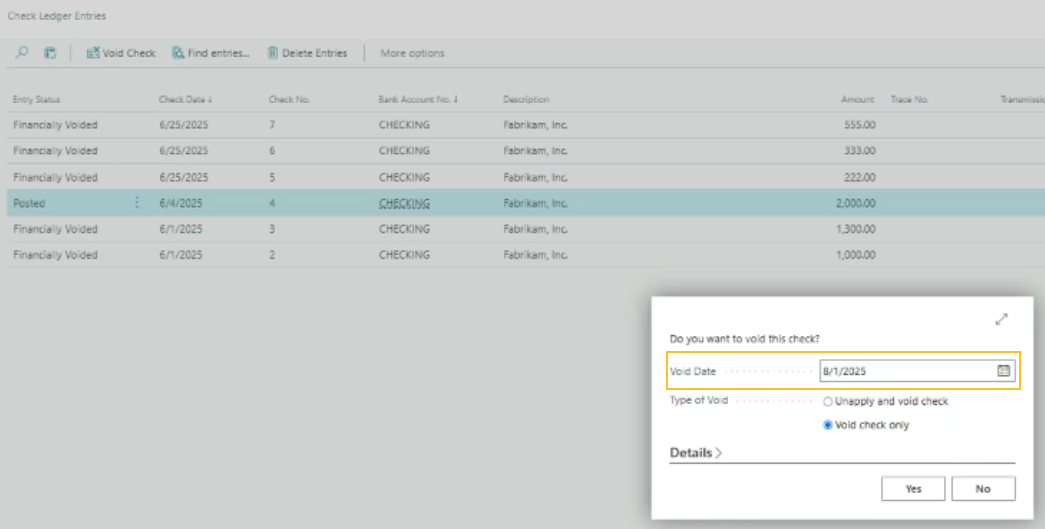

Clears the Entry Cleared checkbox on the same check ledger entry.
PD-5914, PD-6242 
New import functionality to update the Date Cleared field on check ledger entries
This release introduces import functionality that provides the capability for you to update the Date Cleared field on check ledger entries using a .csv file.

To download an import template with example data, select the following link:
Bank Statement Import with Example
To perform an import, use the new Import Cleared Cheques action that appears on the Bank Account Card page.

After you choose the Import Cleared Cheques action, Sparkrock 365 opens the Import Cleared Cheques page where you can specify options, and then choose OK.
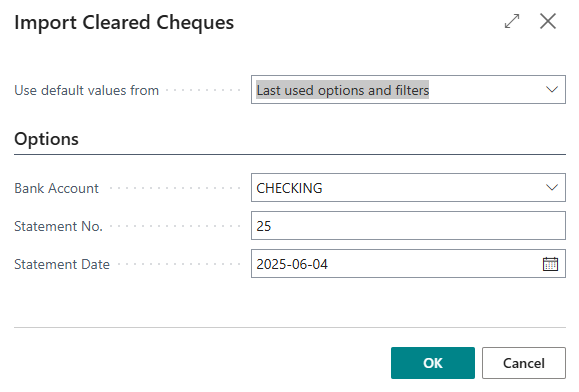
After you choose OK, Sparkrock 365 opens the Select a file to import dialog box.
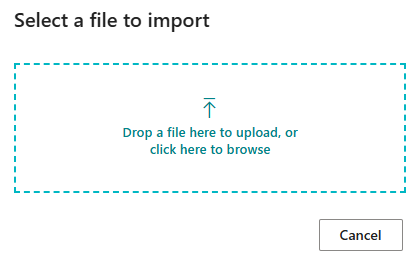
You can then drag your .csv file into the dialog box or browse to the .csv file that you want to import.
After you specify the file, Sparkrock 365 imports the data, and then displays a dialog box that indicates the number of transactions that were cleared or exceptions that were found.
If one or more exceptions are found, Sparkrock 365 creates an exception file and places the file in your browser's downloads folder.

The following screen capture is an example of the exception file.

To learn more, go to Import cleared checks.
Assign allowances on gradual return to work HR requests based on date
Before this release, when processing a gradual return to work HR request, Sparkrock 365 assigned assignment allowances to all assignments included in the request, without considering dates.
Starting with this release, Sparkrock 365 assigns allowances by comparing the dates of the HR employee assignment and the assignment allowance, using the following logic:
Start dates: Sparkrock 365 compares the Calculation Start Date of the HR employee assignment to the Start Date of the allowance, and then uses the later date.
End dates: Sparkrock 365 compares the Calculation End Date of the HR employee assignment to the End Date of the allowance, and then uses the earlier date.
If either the Calculation End Date or End Date is blank, Sparkrock 365 uses the date that is not blank.
If both Calculation End Date and End Date are blank, Sparkrock 365 leaves the end date blank.
Sparkrock 365 considers both start and end dates and treats each allowance individually.
Example
Consider an employee who has the following gradual return to work assignments.
| Assignment | Calculation Start Date | Calculation End Date |
|---|---|---|
| 1 | April 1, 2025 | June 30, 2025 |
| 2 | July 1, 2025 | August 31, 2025 |
| 3 | September 1, 2025 | Blank |
The following allowances exist for Sparkrock 365 to assign.
| Allowance | Start Date | End Date |
|---|---|---|
| 1 | June 1, 2025 | Blank |
| 2 | July 15, 2025 | Blank |
| 3 | September 1, 2025 | Blank |
| 4 | June 1, 2025 | July 14, 2025 |
For this scenario, Sparkrock 365 compares assignment dates to allowance dates, and then assigns the allowances to the assignments based on the logic above.
The end results are:
- Allowance 1 is assigned to all 3 assignments.
- Allowance 2 is assigned to assignment 2 and 3.
- Allowance 3 is assigned to assignment 3.
- Allowance 4 is assigned to assignment 1 and 2.
To learn more, go to Gradually returning employees to work.
Dimension mapping for employer contribution and employer tax liabilities
This release adds the capability to have Sparkrock 365 apply dimension mapping rules to the liability portion of employer contributions and employer taxes when sending related compensation journal lines to payroll. This new functionality provides greater flexibility in financial allocations and reporting.
When processing employer contributions and employer taxes, such as employer-paid benefits or other payroll-related costs, Sparkrock 365 generates two types of accounting entries:
An expense entry, which records the cost that the employer incurs.
A liability entry, which records the amount that the employer owes to a third party, such as a benefits provider or tax authority.
For expense entries, Sparkrock 365 uses the dimension mapping rules that are defined on the Dimension Mapping page to map the HR deduction code to the appropriate General Ledger (G/L) accounts. This level of configuration supports detailed financial tracking and reporting.
However, before this release, Sparkrock 365 did not support the same level of configuration for liability entries. The only available option was to map the HR deduction code to the Liability G/L Account No. field on the HR Deduction Codes page. This limited setup prevented organizations from applying dimension-based allocation to the liability portion.
To address this gap and provide consistent configuration for both types of entries, this release adds dimension mapping functionality that specifically supports the liability portion of employer contributions and employer taxes.
The following sections describe the new functionality in more detail.
New Dimension Mapping (Liabilities for Emp. Contributions) action on the HR Deduction Codes page
On the HR Deduction Codes page, this release introduces a Dimension Mapping (Liabilities for Emp. Contributions) action.
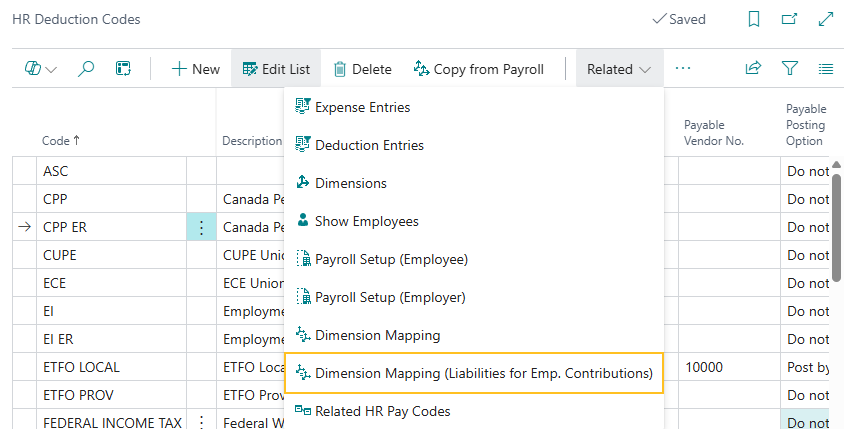
You can use this action to open the Dimension Mappings page where you can configure how Sparkrock 365 is to apply the liability allocations for the HR deduction based on the G/L account and dimension mapping rules when sending related compensation journal lines to payroll.
This action is only enabled when the HR deduction code Type is Employer Contribution or Employer Tax.
New Dimension Mappings page
This release introduces a Dimension Mappings page for liability allocations for the specified employer contribution or employer tax.

On the Dimension Mappings page you can specify the mapping rules that Sparkrock 365 is to apply to liability allocations for the specified employer contribution or employer tax when sending related compensation journal lines to payroll.
Sending compensation journal lines to payroll processing changes
To support the new functionality for liability allocations, this release introduces payroll processing changes when compensation journal lines are sent to payroll.
Processing of allocations for G/L accounts
Sparkrock 365 processes allocations for G/L accounts as described in the sections below.
No dimension mapping entries exist for liabilities for employer contributions or employer taxes
If no dimension mapping entries exist for liabilities for employer contributions or employer taxes, Sparkrock 365 applies mapping based on the rules that are defined on the Dimension Mapping page and the related Liability G/L Account No. field on the HR Deduction Codes page. This is the same behavior as previous releases.
Dimension mapping entries exist for liabilities for employer contributions or employer taxes and a Liability G/L Account No. exists
If mapping rules exist on the Dimension Mapping page for liabilities for employer contributions or employer taxes and a Liability G/L Account No. is specified on the HR Deduction Code page, Sparkrock 365 allocates liabilities as follows, depending on whether G/L account mapping rules exist:
No mapping rules: Sparkrock 365 uses the value from the Liability G/L Account No. field to allocate the liability.
Mapping rules exist: Sparkrock 365 applies the specified mapping rules to allocate the liability to the appropriate G/L account.
Dimension mapping entries exist for liabilities for employer contributions or employer taxes and no Liability G/L Account No. exists
If mapping rules exist on the Dimension Mapping page for liabilities for employer contributions or employer taxes and no Liability G/L Account No. is specified on the HR Deduction Code page, Sparkrock 365 allocates liabilities as follows, depending on whether G/L account mapping rules exist:
No mapping rules: Sparkrock 365 allocates the liability to the G/L account that is specified in the Account No. field on the Payroll Earnings Posting Setup page for the related employer contribution payroll code.
Mapping rules exist: Sparkrock 365 applies the specified mapping rules to allocate the liability to the appropriate G/L account.
Processing of allocations for G/L dimensions
Sparkrock 365 processes allocations for G/L dimensions as described in the sections below.
No dimension mapping entries exist for liabilities for employer contributions or employer taxes
If no mapping rules exist on the Dimension Mapping page for liabilities for employer contributions or employer taxes, Sparkrock 365 applies mapping based on the rules that are defined on the Dimension Mapping page. This is the same behavior as previous releases.
Dimension mapping entries exist for liabilities for employer contributions or employer taxes
If mapping rules exist on the Dimension Mapping page for liabilities for employer contributions or employer taxes, Sparkrock 365 uses the mapping rules to identify, and then replace the dimension values for each allocation line.
View liability allocation results
You can view the liability allocation results on the G/L Entries Preview page when you perform a Preview Posting action on the Payroll Processing page.

Load substitute position assignment data into the employee experience worksheet
To improve the completeness and accuracy of employee experience reporting, this release introduces the capability to load substitute position assignment data into the employee experience worksheet.
Note
Note:
This feature is supported only when the Calculation Method on the Load Employee Experience Worksheet page is set to Actual. The Calculation Method of Elapsed Time is not currently supported.
The following sections describe the new functionality in more detail.
New Substitute Positions field on the Advanced HR Setup page
On the Advanced HR Setup page, this release introduces an Employee Experience Setup FastTab that includes a Substitute Positions field. You use this field to define one or more HR positions that are associated with substitute positions.
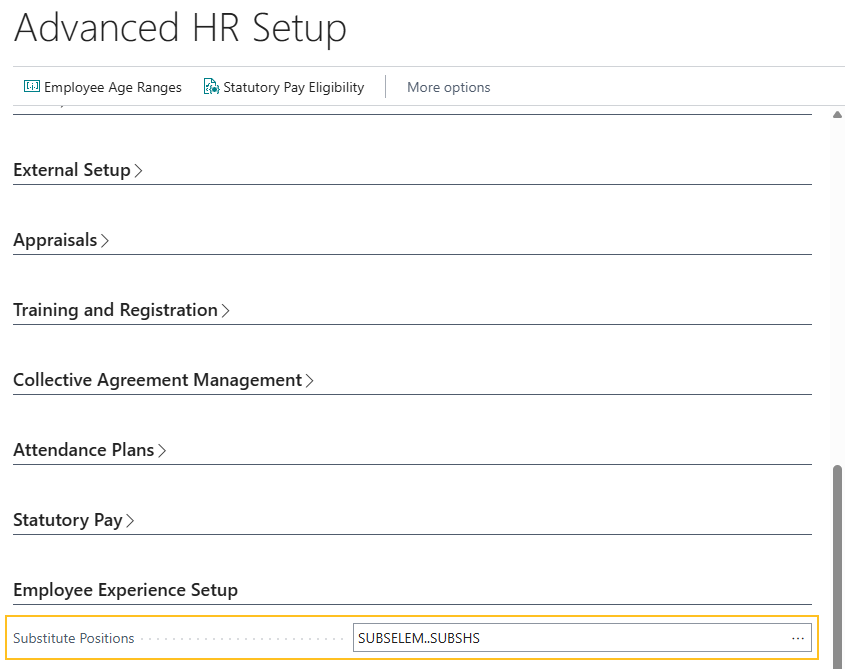
Sparkrock 365 uses the HR position codes that are specified in the Substitute Positions field when loading substitute position assignment lines into the Employee Experience Worksheet page.
To learn more, go to Set up the Advanced HR Setup page.
New Load Substitutes field on the Load Employee Experience Worksheet page
On the Load Employee Experience Worksheet page, this release adds a Load Substitutes field.
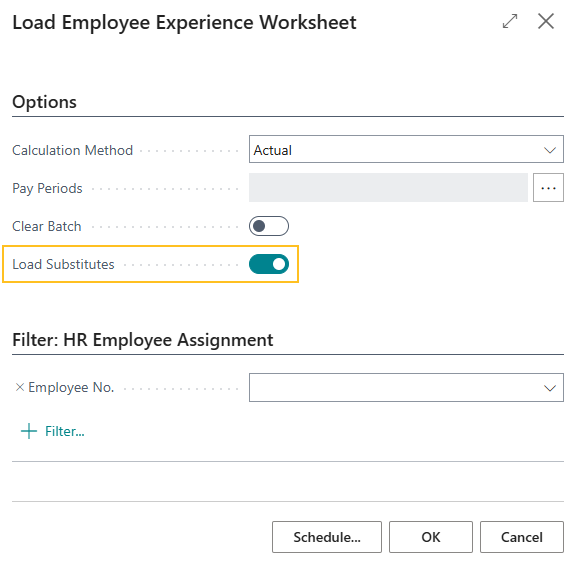
When Load Substitutes is turned on, Sparkrock 365 loads eligible substitute position assignment lines into the Employee Experience Worksheet page. Alternatively, when turned off, Sparkrock 365 does not load substitute position assignment lines.
To learn more, go to Load lines into the employee experience worksheet.
Employee experience worksheet processing changes for substitute position assignments
When loading lines into the Employee Experience Worksheet page, Sparkrock 365 uses the following processing logic for substitute assignments:
If Load Substitutes is turned on, Sparkrock 365 references the Substitute Positions field on the Advanced HR Setup page.
If Load Substitutes is turned off, Sparkrock 365 does not load substitute position assignment lines into the Employee Experience Worksheet page. In this case, processing behaves the same as in previous releases because the new functionality is disabled.
If the Substitute Positions field includes one or more HR position codes, Sparkrock 365 loads lines for compensation ledger entries that are associated with active HR employee assignments for the specified HR position codes and specified Pay Periods. Sparkrock 365 also applies HR employee assignment filters, if specified.
If the Substitute Positions field is blank, Sparkrock 365 does not load substitute position assignment lines into the Employee Experience Worksheet page. In this case, processing behaves the same as in previous releases because no new substitute-related configuration has been defined.
Tip
Tip:
Substitute assignments have an Active FTE of 0.00.
To learn more, go to Employee experience worksheet processing for substitute position assignments.
Gradual return to work HR request enhancements
To improve administration, this release introduces enhancements to gradual return to work HR requests and change gradual return to work HR requests.
The following sections describe the new functionality in more detail.
New fields on the HR Request-Leave Gradual Return and HR Request-Leave Change Return pages
The HR Request-Leave Gradual Return and HR Request-Leave Change Return pages now include several new fields.


The following list describes the new fields:
Pay Grid Code: Specifies the code that represents the pay grid of the position.
Pay Grade: Specifies the code that represents the pay grade within the specified pay grid.
Pay Step: Specifies the pay step within the specified pay grid.
Amount: Specifies the salary amount that is based on the specified pay step. This field is only editable for range-type grids.
Location Code: Specifies the code that represents the school or department location where the employee is to be assigned.
Replacement Employee No.: Specifies the number that represents the employee who is covering the leave period.
Replacement Employee Name: Specifies the employee who is covering the leave period.
On new lines, Sparkrock 365 populates the default values for the new Pay Grid Code, Pay Grade, Pay Step, Amount, and Location Code fields based on the previous assignment or line.
When a gradual return to work or change gradual return to work HR request is processed, Sparkrock 365 automatically updates the related HR employee assignments with the values from these new fields.
In the event that the HR request is reversed, Sparkrock 365 updates the change log for these new fields accordingly.
Gradual return to work HR request date processing changes
When processing gradual return to work HR requests, Sparkrock 365 now populates dates as described in the following list:
Defaults the Calculation Start Date on the HR Request-Leave Gradual Return page based on the specified assignment.
Automatically calculates the Calculation End Date on the related assignment as one day before the Calculation Start Date of the next assignment.
Automatically populates the Assignment Start Date on the related assignment with the Calculation Start Date.
Automatically populates the Assignment End Date on the related assignment with the Calculation End Date.
Example
Consider an employee who has a leave assignment with a Calculation Start Date of January 1, 2025 and where the Calculation End Date is blank.
On the HR Request-Leave Gradual Return page, the calculation start dates appear as shown in the following table.
| Line | Calculation Start Date |
|---|---|
| 1 | February 1, 2025 |
| 2 | March 1, 2025 |
When the HR request is processed, Sparkrock 365 performs the following actions:
Update the leave assignment Calculation End Date to be January 31, 2025 (January 31, 2025=February 1, 2025 - 1 day).
Updates the gradual return to work assignment dates as shown in the following table.
Assignment Calculation Start Date Calculation End Date Assignment Start Date Assignment End Date 1 February 1, 2025 February 28, 2025
(February 28, 2025 = March 1, 2025 - 1 day)February 1, 2025 February 28, 2025
(February 28, 2025 = March 1, 2025 - 1 day)2 March 1, 2025 Blank March 1, 2025 Blank
To learn more about gradually returning employees to work, go to Gradually returning employees to work.
Employee experience worksheet enhancements
Before this release, to calculate Days Worked, Experience Years, and Seniority Years in the employee experience worksheet, Sparkrock 365 required the Start Date and End Date fields to be populated. Some customers found this design challenging because it is difficult to obtain exact dates from historical records. For example, school boards can encounter difficulty obtaining precise dates when onboarding new hires from other districts. As a result, these customers were forced to estimate dates, introducing inefficiency and increasing the risk of inaccurate data.
To eliminate unnecessary date estimation and streamline data entry during onboarding, this release introduces several employee experience worksheet enhancements. With these enhancements, customers can manage employee experience more accurately without relying on Sparkrock 365 to perform date calculations.
The following sections describe the new functionality in more detail.
Days Worked, Experience Years, and Seniority Years are now editable
On the Employee Experience Worksheet page, the Days Worked, Experience Years, and Seniority Years fields are now editable.

Sparkrock 365 accepts any value that is greater than zero in these fields.
To learn more about editing fields in the employee experience worksheet, go to Edit lines in the employee experience worksheet.
Start Date and End Date fields are now optional
On the Employee Experience Worksheet page, the Start Date and End Date fields are now optional.

Posting updates
When posting employee experience worksheet lines, Sparkrock now successfully posts the following types of records:
- Lines where the Start Date and End Date are blank.
- Lines where the Days Worked, Experience Years, and Seniority Years fields have been edited.
To learn more about posting employee experience worksheet lines, go to Post employee experience to the employee experience ledger.
Support for identifying HR employee assignments without allocations
To help you identify employee assignments that do not have allocations set up, this release introduces an Assignments without Allocations cue to the Human Resources Manager role center.

The Assignments without Allocations cue displays the number of employee assignments that meet all the following criteria:
- Entry Type = Assignment
- Active FTE = 0.00
- Leave FTE = 0.00
- The Calculation Start Date is not blank and is less than or equal to the Work Date.
- The Calculation End Date is blank or greater than or equal to the Work Date."
Selecting the cue opens a filtered view of the HR Employee Assignments page that displays records matching this criteria.
To control whether the cue appears on the Human Resources Manager role center, this release introduces on the Advanced HR Setup page, on the new HR Requests Setup FastTab, an Enforce Allocations to add up to 100% field.

When the Enforce Allocations to add up to 100% field is turned on, the cue is displayed. Alternatively, when Enforce Allocations to add up to 100% field is turned off, the cue is hidden.
Tip
Tip:
You can set up a colored indicator for this cue. To learn more, go to Set Up a Colored Indicator on Cues for the Company or Individual Users.
To learn more about this feature, go to Set up the Assignments without Allocations cue.
Create HR requests directly from HR employee assignments
To improve administration of HR requests, this release introduces the capability to create HR requests directly from HR assignments.
On the HR Employee Assignments and HR Employee Assignment Card pages, a new Create HR Request action is now available under Actions.


When you choose Create HR Request, Sparkrock 365 opens the HR Reason Codes page so you can select an HR reason code. After you choose OK, the HR Request page opens where you can specify the remaining details for the request.
To learn more about HR requests, go to HR requests.
Filter HR request worksheet by user
Before this release, when you opened the HR Request Worksheet page, Sparkrock 365 displayed all lines created by all users. This design made it difficult if you wanted to work with only the lines that you created.
To resolve this issue, this release introduces the capability to filter HR request worksheet lines by user. When the feature is enabled, Sparkrock 365 displays only the lines that you created by default. Additionally, when the worksheet is filtered and you choose the Process All Lines or Process Selected Lines actions, Sparkrock 365 processes only the filtered lines.
If required, you can adjust the page filters to view all records and process lines that other users have created.
To enable this feature, go to the Advanced HR Setup page, and then turn on the new Filter HR Request Worksheet by User field.

To learn more, go to Set up the HR request worksheet to be filtered by user.
New benefit-related fields to improve payroll administration
To improve payroll administration, this release introduces the following new benefits related fields:
- Amount Formula - EE: Specifies whether Sparkrock 365 uses a fixed amount or a percentage of gross wages to calculate employee deductions for this benefit plan for the employee.
- Amount Percent / EE: Specifies the value of the fixed amount or percentage of gross wages that Sparkrock uses to calculate employee deductions for this benefit plan for the employee.
- Amount Formula - ER: Specifies whether Sparkrock 365 uses a fixed amount or a percentage of gross wages to calculate employer contributions for this benefit plan for the employee.
- Amount Percent - ER: Specifies the value of the fixed amount or percentage of gross wages that Sparkrock uses to calculate employer contributions for this benefit plan for the employee.
- Coverage Amount: Specifies the coverage amount that Sparkrock 365 applies to this benefit plan for the employee.
You can specify values for these new fields on HR requests that display the Employee Benefits FastTab on the related details page.
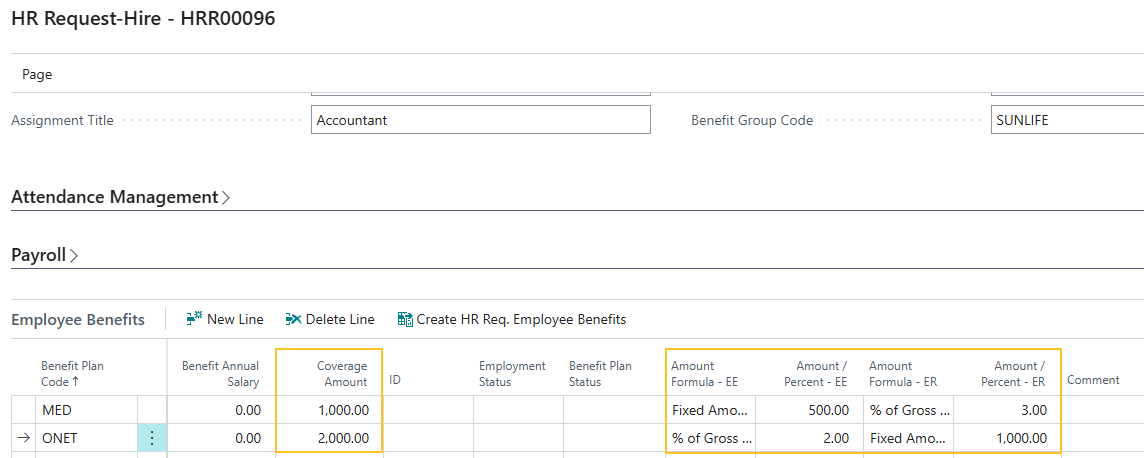
When the HR request is processed, Sparkrock 365 updates the corresponding values on the employee's Employee Benefits page.

You can define default values for these fields, except for Coverage Amount, on the Benefit Group Plans page.

To learn more, go to Hire or rehire employees and Set up benefit group plans.
Support for identifying employees with active assignments ending soon and no future-dated assignments
To help identify employees whose active assignments are all ending within the next 30 days and who have no future-dated assignments, this release introduces an Employees About to Become Inactive cue to the Human Resources Manager role center.

The Employees About to Become Inactive cue displays the number of employees who meet all the following criteria:
- All current active assignments, including leave assignments, have a Calculation End Date, Assignment End Date, or both that fall within 30 days of the Work Date. Sparkrock 365 considers an assignment to be active when the Active FTE or Leave FTE is greater than 0.00. If both Active FTE and Leave FTE are 0.00 and no other active assignments exist, the employee is counted in the cue total.
- No future-dated assignments exist.
- The Status that appears on the Employee Card page is equal to Active.
Selecting the cue opens a filtered view of the Employees page that lists employees who meet this criteria.
Payroll has been updated to version 25.42.1.0
To stay current with the latest payroll updates and fixes, payroll has been updated to 25.42.1.0.
For more information, see Payroll release notes version 25.42.1.0.
Payroll performance improvements
The following sections describe the payroll performance improvements in this release.
New Compensation Journal ID field on the Primo Payday Integration Setup page
To improve payroll performance, this release introduces on the Primo Payday Integration Setup page, on the Sync FastTab, a Compensation Journal ID field.
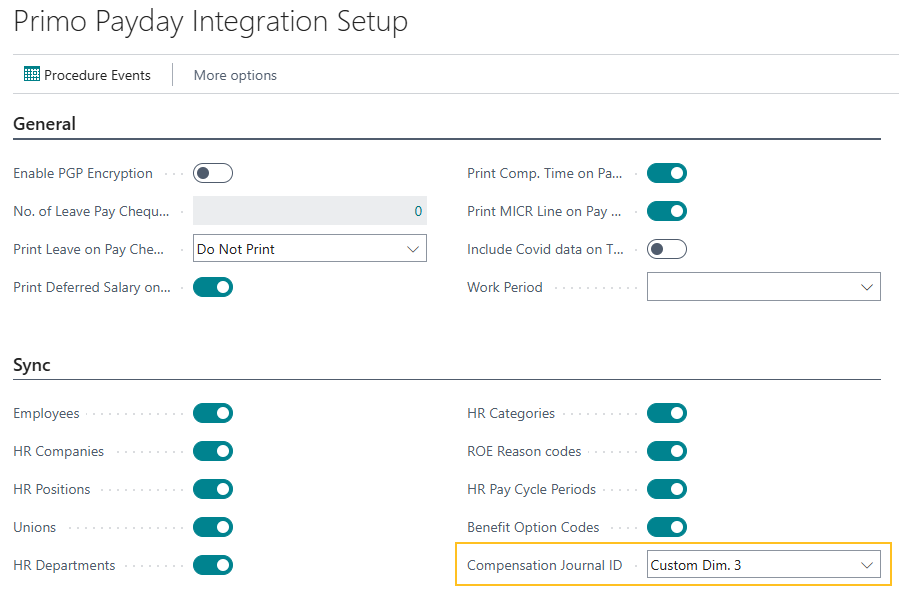
The Compensation Journal ID field specifies the payroll custom dimension that is used to filter hours details records during payroll processing.
To learn more, go to Set up payroll custom dimensions to improve performance.
Payroll Setup page is updated automatically with the Compensation Journal ID field from the Primo Payday Integration Setup page
When you update the Compensation Journal ID field on the Primo Payday Integration Setup page, Sparkrock 365 automatically updates the respective fields on the Payroll Setup page based on the value that was selected. For example, if you specify Custom Dim. 8, Sparkrock 365 automatically updates the fields as described in the following table.
| Field | Value |
|---|---|
| Custom Payroll Dimension 8 Code | COMP JOURNAL ID |
| Custom Dim. 8 Validation Table ID | 23068648 |
| Custom Dim. 8 Validation Field ID | 23068816 |
| Filter Hours Detail by | Custom Dim. 8 |
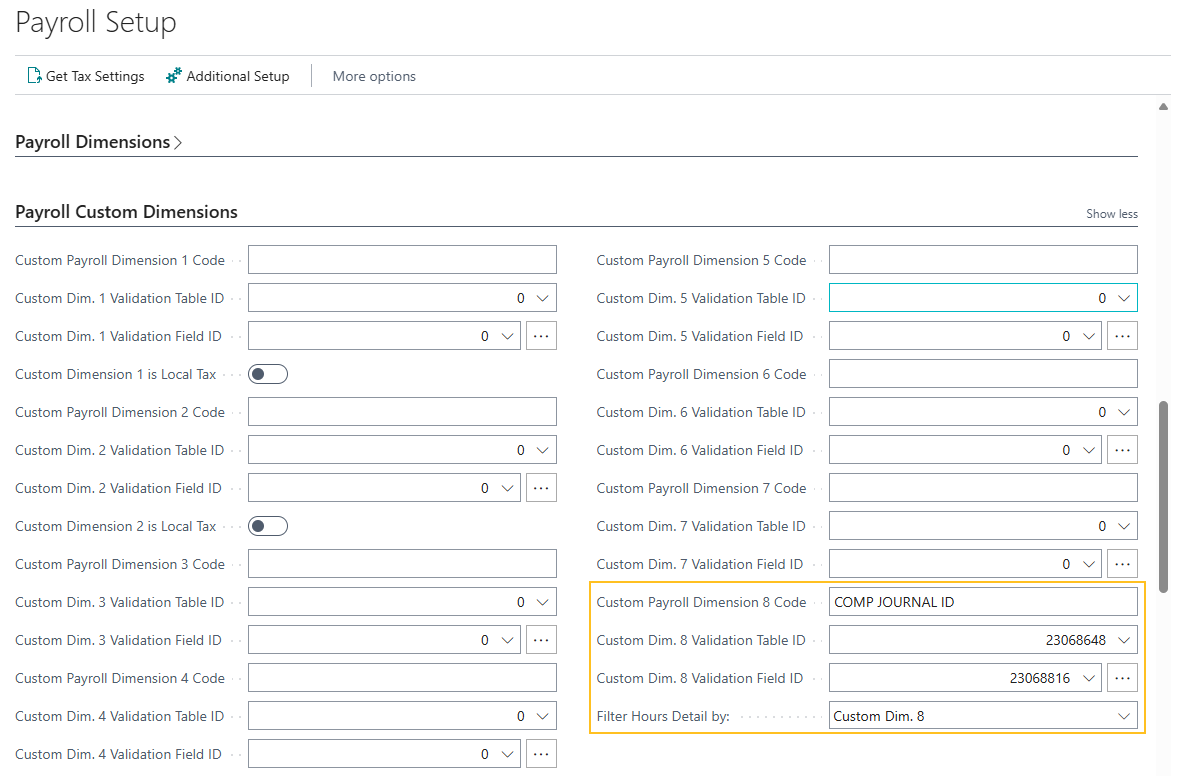
To learn more, go to Set up payroll custom dimensions to improve performance.
The Compensation Journal ID is now updated on Hours Details records for custom payroll dimensions 5 to 8
Before this release, when you sent compensation journal lines to payroll, Sparkrock 365 only updated the COMP JNL ID field on the Hours Details page for custom payroll dimension 2 to 4. With this release, the COMP JNL ID field is now updated for custom payroll dimensions 2 through 8.

To learn more, go to Set up payroll custom dimensions to improve performance.
Default filters during payroll batch creation processing
Starting with this release, when you send compensation journal lines to payroll, Sparkrock 365 might, depending on the payroll setup, default the Custom Dimension Filter and remove the payroll employee No. filter during payroll batch creation processing.
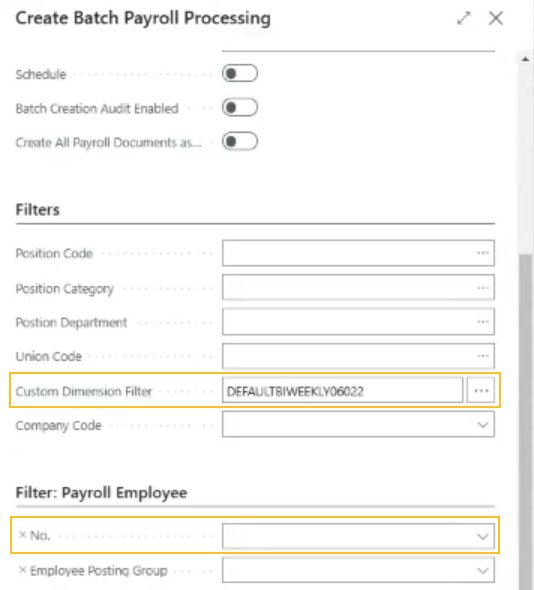
When all the following conditions are met, Sparkrock 365 removes filtering by payroll employee numbers and specifies a Custom Dimension Filter:
On the Primo Payday Integration Setup page, the Compensation Journal ID field is synced to a custom payroll dimension.

On the Payroll Setup page, the Filter Hours Details by field is synced to the same custom payroll dimension.
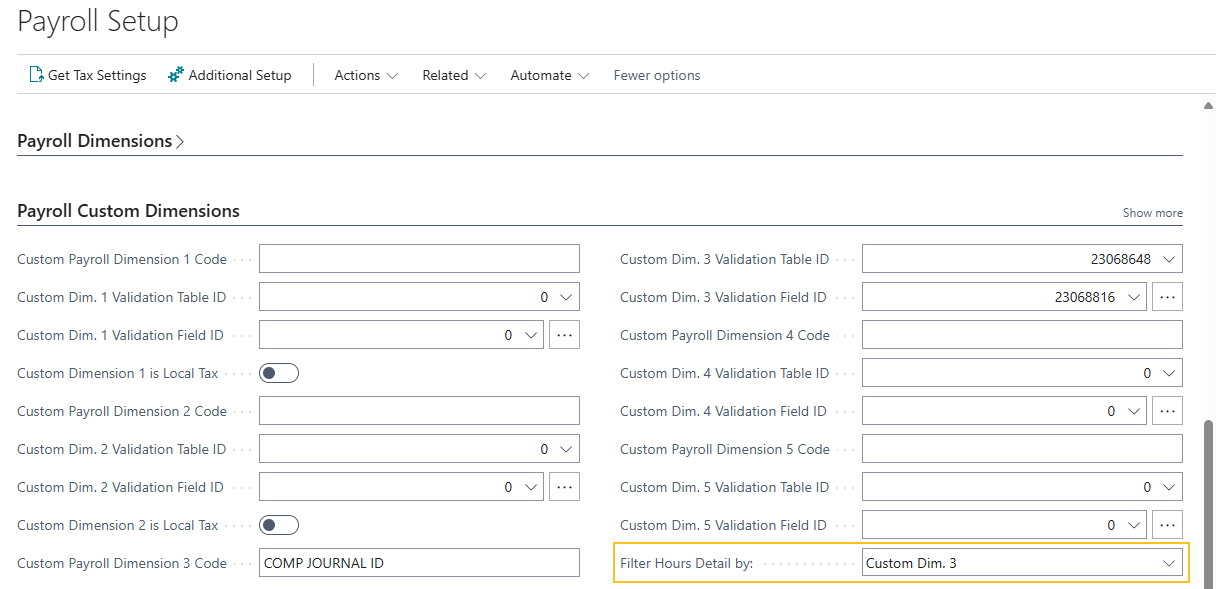
On the Payroll Setup page, the selected custom payroll dimension is configured to use the compensation journal ID.
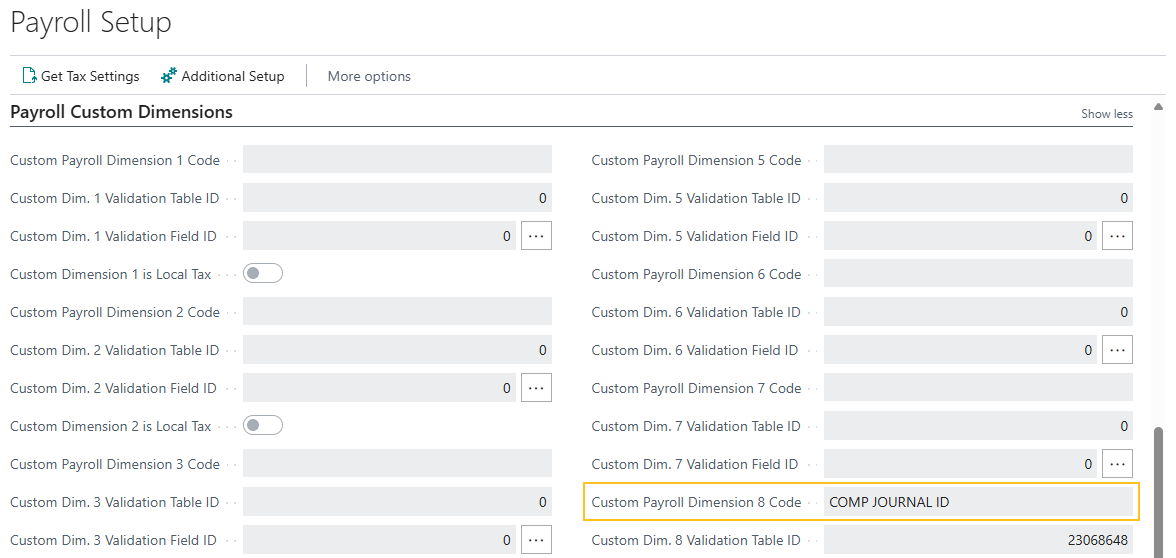
If any of the above conditions are not met, Sparkrock 365 behaves the same as previous releases and continues to specify payroll employee number filters by default.
To learn more, go to Set up payroll custom dimensions to improve performance.
Update considerations
Consider the following information before updating to version 25.3 for Sparkrock 365 2024 release wave 2.
User groups must be migrated to security groups or permission sets
Important
Important:
User group functionality is no longer available with this release.
If you use user groups, before you update to this version, you must migrate your user groups to security groups or permission sets. To learn more, go to User groups migration.
Known problems
The following sections include information about the known problems in version 25.3 for Sparkrock 365 2024 release wave 2.
Documents Factbox does not display the Upload files option for limited access users
The Documents FactBox does not display the Upload files option for limited access users.

Workaround
To upload files when you are a limited access user, perform the following steps:
In the Documents FactBox, choose Show Details.
The Attached Documents page opens.
Depending on whether there are existing attachments, perform one of the following steps:
No existing attachments: In the Attachment column, choose Attach File(s)….
Existing attachments: To add a line, on the action bar, choose New, and then choose Attach File(s)….
An Attach a document dialog box appears.
Drop a file in the box. Alternatively, browse to the file that you want to attach, and then choose Open.
PD-6052
Error: The Sustainability Setup does not exist. Identification fields and values: Primary Keys=''
Users may encounter the following error:
The Sustainability Setup does not exist. Identification fields and values: Primary Keys=''
Workaround
To resolve this problem, perform the following actions:
Open the Sustainability Setup page. To open the page, choose
 , enter sustainability setup, and then choose the related link.
, enter sustainability setup, and then choose the related link.Ensure that affected users have the permission sets that are listed in the table below.
Permission Set Name Type Extension Name SUSTAINABILITY, ADMIN Sustainability - Admin System Sustainability SUSTAINABILITY, EDIT Sustainability - Edit System Sustainability SUSTAINABILITY, READ Sustainability - Read System Sustainability To learn more, go to Assign permissions to users and groups.
mySparkrock users cannot view data sets
mySparkrock users cannot view data sets because the MYSPARKROCK user is missing permission sets.
Workaround
To resolve this problem, perform the following steps:
In Sparkrock 365, choose
 , enter microsoft entra applications, and then choose the related link.
, enter microsoft entra applications, and then choose the related link.The Microsoft Entra Applications page opens.
Select the row that has a Description of mySparkrock, and then on the action bar, choose Manage > Edit.
The Microsoft Entra Application Card page opens.
On the User Permission Sets FastTab, add the records that appear in the following table.
Permission Set Name Type Extension Name SPKFA ANALYSIS, EDIT SR365 Create Fin. Analysis System Financial Analysis SPKFA ANALYSIS, VIEW SR365 View Financial Analysis System Financial Analysis SPKFA DATA SET, EDIT SR365 Create data sets System Financial Analysis SPKFA DATA SET, VIEW SR365 View data sets System Financial Analysis To add a record, choose Manage > New Line, and then specify values for fields as required.
Connectivity issue with APIs and other services or integrations
After updating to this release, you may experience connectivity issues with APIs and other services or integrations.
The following list includes examples of how connectivity issues may become apparent:
API errors
Power BI dashboards may no longer work correctly
Integrations may have trouble communicating with Sparkrock 365
Workaround
To resolve this problem, you must uninstall, and then install the respective extension. To uninstall, and then install the extension, perform the following steps:
In Sparkrock 365, choose
 , enter extension management, and then choose the related link.
, enter extension management, and then choose the related link.The Extension Management page opens.
In Search, enter api.

A list of the API extensions are displayed, for example, PS Finance APIs.
You may have to change your view so that you can view the version number for any extension. To view the version number for all extensions, choose
 , and then choose List.
, and then choose List.
For each extension that does not have a version that starts with v.25.3 and Is Installed is selected, perform the following steps to uninstall, and then install the extension:
- Select the extension that you want to update, and then on the action bar, choose Manage > Uninstall.
The Extension Uninstallation page opens. - Choose Uninstall.
A dialog box appears and displays text that indicates the extension was successfully uninstalled. - To close the dialog box, choose OK.
- Select the extension that you want to update, and then on the action bar, choose Manage > Install.
The Extension Installation page opens. - Choose Next.
The page refreshes and you are requested to review extension information before installation. - To proceed, turn on I accept the terms and conditions.
- Choose Install.
The extension is updated to the latest version.
- Select the extension that you want to update, and then on the action bar, choose Manage > Uninstall.
Alternate workaround
It is possible that custom web services may have been deleted during or after the update.
To resolve this problem, you must copy and paste the web services lines from a sandbox environment into your production environment.
To copy and paste one or more web services lines, perform the following steps:
Open a Sparkrock 365 sandbox environment that was created before the update or create a sandbox environment from a backup.
Select Search (Alt+Q)
 , enter web services, and then choose the related link.
, enter web services, and then choose the related link.The Web Services page opens.
Copy the information for the one or more lines that you want to copy.
In your Sparkrock 365 production environment, choose
 , enter web services, and then choose the related link.
, enter web services, and then choose the related link.The Web Services page opens.
Paste the information for the one or more lines that you copied.
Re-open button is missing for a submitted expense claim in mySparkrock
The Re-open button may disappear from a submitted expense claim in mySparkrock. This issue occurs when the MYSPARKROCK user is not set up in Sparkrock 365, on the User Setup page.
Workaround
Perform the following steps:
Select Search (Alt+Q)
 , enter user setup, and then choose the related link.
, enter user setup, and then choose the related link.The User Setup page opens.
On the action bar, choose New.
A new row appears.
In User ID, specify MYSPARKROCK.
Assign all permissions to this specific user.
For example, select the checkboxes for the following fields:
- A/P Batch Admin
- Allow A/P Batch Creation
- Allow A/P Batch Auditing
- Allow A/P Batch Deletion
- Allow User to Access Compensation Data
- HR Request Reversal Allowed
Electronic Funds Transfer (EFT) errors
The following setup scenarios may result in an Electronic Funds Transfer (EFT) error:
On the Countries/Regions page, ISO Code and ISO Numeric Code are blank, and on the Field Mapping page of the respective data exchange definition, on the Bank No. row, the Optional checkbox is selected.
For this scenario, Sparkrock 365 may generate an EFT file successfully, but the bank may reject the file.
On the Countries/Regions page, ISO Code and ISO Numeric Code are blank, and on the Field Mapping page of the respective data exchange definition, on the Bank No. row, the Optional checkbox is clear.
For this scenario, when you try to generate an Electronic Funds Transfer (EFT) bank import file, Sparkrock 365 may display an error, for example:
Fin. Institution Transit No. must have a value in ACH RB Detail: Data Exch. Entry No.=3, Data Exch. Line Def Code=DETAIL. It cannot be zero or empty.
Workaround
On the Countries/Regions page, ensure that you have a value specified in ISO Code and ISO Numeric Code.
For Canadian banks, specify the following:
- In ISO Code, specify CA.
- In ISO Number Code, specify 124.
For United States of America banks, specify the following:
- In ISO Code, specify US.
- In ISO Number Code, specify 840.
Transaction cannot be completed because it will cause inconsistencies in the G/L Entry table error
When you try to post a purchase invoice for a vendor that has a foreign trade Currency Code set up, for example, USD, you may receive the following error:
This transaction cannot be completed because it will cause inconsistencies in the G/L Entry table. Check where and how the CONSISTENT function is used in the transaction to find the reason for the error.
Contact your system administrator.
Tables can be marked as inconsistent during comprehensive tasks, such as posting. This prevents data from being updated incorrectly.
Workaround
On the Change Exchange Rate page for the specific invoice, increase the number of decimal places for the value in the Relational Exch. Rate Amount field, for example, from 1.4286 to 1.428571.
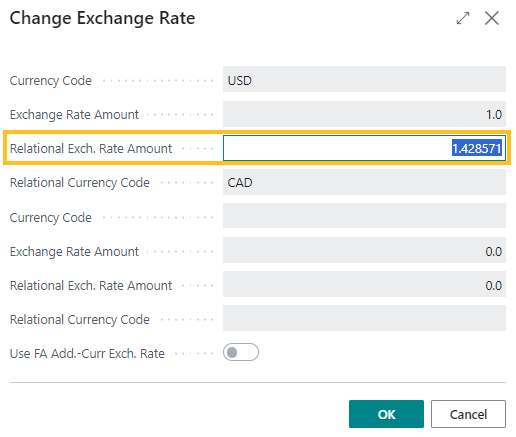
Alternate workaround
On the Currency Card page of the respective currency, increase the number of decimal places for the value in the Amount Rounding Precision field, for example, from 0.01 to 0.001.
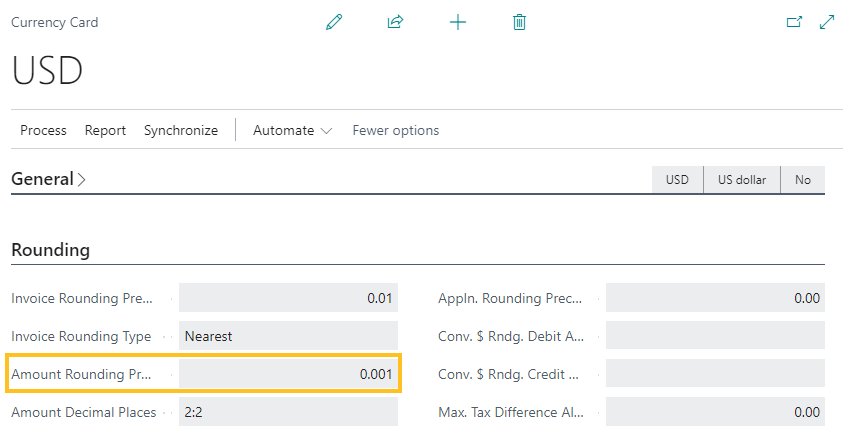
Cannot open links in sent emails
When you open a sent email from the Sent Emails Last 30 Days page, and then select the link that appears in the body of the email, Sparkrock 365 becomes unresponsive.
Workaround
Open links in the body of sent emails from Gmail or Outlook, instead of from Sparkrock 365.
Payroll Employee or Payroll Processing pages may fail to open
When using the platform security filters on permission sets, the Payroll Employee page, Payroll Processing page, or both pages may fail to open with a something went wrong error message. This is a limitation of the payroll processing module.
Workaround
Remove the permission sets with security filters from the user who must access these pages.
Related information
New for Sparkrock Impact
Version 25.3 for mySparkrock 2024 Release Wave 2 Release Notes
Payroll releases
Feedback
To send feedback about this page, select the following link:
